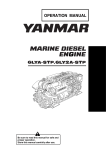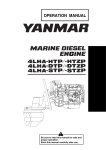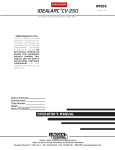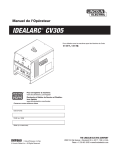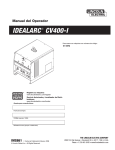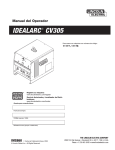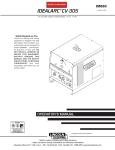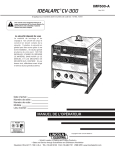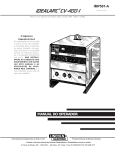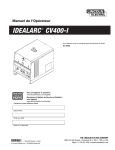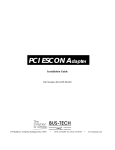Download Lincoln Electric IM709 User's Manual
Transcript
RETURN TO MAIN INDEX Demo Zone For use with equipment having “K” Number: IM709 ™ December, 2000 K1854-1 Safety Depends on You Lincoln arc welding and cutting equipment is designed and built with safety in mind. However, your overall safety can be increased by proper installation ... and thoughtful operation on your part. DO NOT INSTALL, OPERATE OR REPAIR THIS EQUIPMENT WITHOUT READING THIS MANUAL AND THE SAFETY PRECAUTIONS CONTAINED THROUGHOUT. And, most importantly, think before you act and be careful. OPERATOR’S MANUAL Copyright © 2001 Lincoln Global Inc. • World's Leader in Welding and Cutting Products • • Sales and Service through Subsidiaries and Distributors Worldwide • Cleveland, Ohio 44117-1199 U.S.A. TEL: 216.481.8100 FAX: 216.486.1751 WEB SITE: www.lincolnelectric.com i i SAFETY WARNING CALIFORNIA PROPOSITION 65 WARNINGS Diesel engine exhaust and some of its constituents are known to the State of California to cause cancer, birth defects, and other reproductive harm. The Above For Diesel Engines The engine exhaust from this product contains chemicals known to the State of California to cause cancer, birth defects, or other reproductive harm. The Above For Gasoline Engines ARC WELDING CAN BE HAZARDOUS. PROTECT YOURSELF AND OTHERS FROM POSSIBLE SERIOUS INJURY OR DEATH. KEEP CHILDREN AWAY. PACEMAKER WEARERS SHOULD CONSULT WITH THEIR DOCTOR BEFORE OPERATING. Read and understand the following safety highlights. For additional safety information, it is strongly recommended that you purchase a copy of “Safety in Welding & Cutting - ANSI Standard Z49.1” from the American Welding Society, P.O. Box 351040, Miami, Florida 33135 or CSA Standard W117.2-1974. A Free copy of “Arc Welding Safety” booklet E205 is available from the Lincoln Electric Company, 22801 St. Clair Avenue, Cleveland, Ohio 44117-1199. BE SURE THAT ALL INSTALLATION, OPERATION, MAINTENANCE AND REPAIR PROCEDURES ARE PERFORMED ONLY BY QUALIFIED INDIVIDUALS. FOR ENGINE powered equipment. 1.h. To avoid scalding, do not remove the radiator pressure cap when the engine is hot. 1.a. Turn the engine off before troubleshooting and maintenance work unless the maintenance work requires it to be running. ____________________________________________________ 1.b. Operate engines in open, well-ventilated areas or vent the engine exhaust fumes outdoors. ____________________________________________________ 1.c. Do not add the fuel near an open flame welding arc or when the engine is running. Stop the engine and allow it to cool before refueling to prevent spilled fuel from vaporizing on contact with hot engine parts and igniting. Do not spill fuel when filling tank. If fuel is spilled, wipe it up and do not start engine until fumes have been eliminated. ____________________________________________________ 1.d. Keep all equipment safety guards, covers and devices in position and in good repair.Keep hands, hair, clothing and tools away from V-belts, gears, fans and all other moving parts when starting, operating or repairing equipment. ____________________________________________________ 1.e. In some cases it may be necessary to remove safety guards to perform required maintenance. Remove guards only when necessary and replace them when the maintenance requiring their removal is complete. Always use the greatest care when working near moving parts. ___________________________________________________ 1.f. Do not put your hands near the engine fan. Do not attempt to override the governor or idler by pushing on the throttle control rods while the engine is running. ELECTRIC AND MAGNETIC FIELDS may be dangerous 2.a. Electric current flowing through any conductor causes localized Electric and Magnetic Fields (EMF). Welding current creates EMF fields around welding cables and welding machines 2.b. EMF fields may interfere with some pacemakers, and welders having a pacemaker should consult their physician before welding. 2.c. Exposure to EMF fields in welding may have other health effects which are now not known. 2.d. All welders should use the following procedures in order to minimize exposure to EMF fields from the welding circuit: 2.d.1. Route the electrode and work cables together - Secure them with tape when possible. 2.d.2. Never coil the electrode lead around your body. 2.d.3. Do not place your body between the electrode and work cables. If the electrode cable is on your right side, the work cable should also be on your right side. 2.d.4. Connect the work cable to the workpiece as close as possible to the area being welded. ___________________________________________________ 1.g. To prevent accidentally starting gasoline engines while turning the engine or welding generator during maintenance work, disconnect the spark plug wires, distributor cap or magneto wire as appropriate. 2.d.5. Do not work next to welding power source. Mar ‘95 DEMO ZONE ii ii SAFETY ARC RAYS can burn. ELECTRIC SHOCK can kill. 3.a. The electrode and work (or ground) circuits are electrically “hot” when the welder is on. Do not touch these “hot” parts with your bare skin or wet clothing. Wear dry, hole-free gloves to insulate hands. 3.b. Insulate yourself from work and ground using dry insulation. Make certain the insulation is large enough to cover your full area of physical contact with work and ground. In addition to the normal safety precautions, if welding must be performed under electrically hazardous conditions (in damp locations or while wearing wet clothing; on metal structures such as floors, gratings or scaffolds; when in cramped positions such as sitting, kneeling or lying, if there is a high risk of unavoidable or accidental contact with the workpiece or ground) use the following equipment: • Semiautomatic DC Constant Voltage (Wire) Welder. • DC Manual (Stick) Welder. • AC Welder with Reduced Voltage Control. 4.a. Use a shield with the proper filter and cover plates to protect your eyes from sparks and the rays of the arc when welding or observing open arc welding. Headshield and filter lens should conform to ANSI Z87. I standards. 4.b. Use suitable clothing made from durable flame-resistant material to protect your skin and that of your helpers from the arc rays. 4.c. Protect other nearby personnel with suitable, non-flammable screening and/or warn them not to watch the arc nor expose themselves to the arc rays or to hot spatter or metal. FUMES AND GASES can be dangerous. 5.a. Welding may produce fumes and gases hazardous to health. Avoid breathing these fumes and gases.When welding, keep your head out of the fume. Use enough ventilation and/or exhaust at the arc to keep fumes and gases away from the breathing zone. When welding with electrodes which require special ventilation such as stainless or hard facing (see instructions on container or MSDS) or on lead or cadmium plated steel and other metals or coatings which produce highly toxic fumes, keep exposure as low as possible and below Threshold Limit Values (TLV) using local exhaust or mechanical ventilation. In confined spaces or in some circumstances, outdoors, a respirator may be required. Additional precautions are also required when welding on galvanized steel. 3.c. In semiautomatic or automatic wire welding, the electrode, electrode reel, welding head, nozzle or semiautomatic welding gun are also electrically “hot”. 3.d. Always be sure the work cable makes a good electrical connection with the metal being welded. The connection should be as close as possible to the area being welded. 3.e. Ground the work or metal to be welded to a good electrical (earth) ground. 3.f. Maintain the electrode holder, work clamp, welding cable and welding machine in good, safe operating condition. Replace damaged insulation. 3.g. Never dip the electrode in water for cooling. 3.h. Never simultaneously touch electrically “hot” parts of electrode holders connected to two welders because voltage between the two can be the total of the open circuit voltage of both welders. 3.i. When working above floor level, use a safety belt to protect yourself from a fall should you get a shock. 3.j. Also see Items 6.c. and 8. 5.b. Do not weld in locations near chlorinated hydrocarbon vapors coming from degreasing, cleaning or spraying operations. The heat and rays of the arc can react with solvent vapors to form phosgene, a highly toxic gas, and other irritating products. 5.c. Shielding gases used for arc welding can displace air and cause injury or death. Always use enough ventilation, especially in confined areas, to insure breathing air is safe. 5.d. Read and understand the manufacturer’s instructions for this equipment and the consumables to be used, including the material safety data sheet (MSDS) and follow your employer’s safety practices. MSDS forms are available from your welding distributor or from the manufacturer. 5.e. Also see item 1.b. Mar ‘95 DEMO ZONE iii iii SAFETY WELDING SPARKS can cause fire or explosion. CYLINDER may explode if damaged. 6.a. Remove fire hazards from the welding area. If this is not possible, cover them to prevent the welding sparks from starting a fire. Remember that welding sparks and hot materials from welding can easily go through small cracks and openings to adjacent areas. Avoid welding near hydraulic lines. Have a fire extinguisher readily available. 6.b. Where compressed gases are to be used at the job site, special precautions should be used to prevent hazardous situations. Refer to “Safety in Welding and Cutting” (ANSI Standard Z49.1) and the operating information for the equipment being used. 7.a. Use only compressed gas cylinders containing the correct shielding gas for the process used and properly operating regulators designed for the gas and pressure used. All hoses, fittings, etc. should be suitable for the application and maintained in good condition. 7.b. Always keep cylinders in an upright position securely chained to an undercarriage or fixed support. 7.c. Cylinders should be located: • Away from areas where they may be struck or subjected to physical damage. 6.c. When not welding, make certain no part of the electrode circuit is touching the work or ground. Accidental contact can cause overheating and create a fire hazard. 6.d. Do not heat, cut or weld tanks, drums or containers until the proper steps have been taken to insure that such procedures will not cause flammable or toxic vapors from substances inside. They can cause an explosion even though they have been “cleaned”. For information, purchase “Recommended Safe Practices for the Preparation for Welding and Cutting of Containers and Piping That Have Held Hazardous Substances”, AWS F4.1 from the American Welding Society (see address above). 6.e. Vent hollow castings or containers before heating, cutting or welding. They may explode. 6.f. Sparks and spatter are thrown from the welding arc. Wear oil free protective garments such as leather gloves, heavy shirt, cuffless trousers, high shoes and a cap over your hair. Wear ear plugs when welding out of position or in confined places. Always wear safety glasses with side shields when in a welding area. 6.g. Connect the work cable to the work as close to the welding area as practical. Work cables connected to the building framework or other locations away from the welding area increase the possibility of the welding current passing through lifting chains, crane cables or other alternate circuits. This can create fire hazards or overheat lifting chains or cables until they fail. 6.h. Also see item 1.c. • A safe distance from arc welding or cutting operations and any other source of heat, sparks, or flame. 7.d. Never allow the electrode, electrode holder or any other electrically “hot” parts to touch a cylinder. 7.e. Keep your head and face away from the cylinder valve outlet when opening the cylinder valve. 7.f. Valve protection caps should always be in place and hand tight except when the cylinder is in use or connected for use. 7.g. Read and follow the instructions on compressed gas cylinders, associated equipment, and CGA publication P-l, “Precautions for Safe Handling of Compressed Gases in Cylinders,” available from the Compressed Gas Association 1235 Jefferson Davis Highway, Arlington, VA 22202. FOR ELECTRICALLY powered equipment. 8.a. Turn off input power using the disconnect switch at the fuse box before working on the equipment. 8.b. Install equipment in accordance with the U.S. National Electrical Code, all local codes and the manufacturer’s recommendations. 8.c. Ground the equipment in accordance with the U.S. National Electrical Code and the manufacturer’s recommendations. Mar ‘95 DEMO ZONE iv SAFETY iv zones où l’on pique le laitier. PRÉCAUTIONS DE SÛRETÉ Pour votre propre protection lire et observer toutes les instructions et les précautions de sûreté specifiques qui parraissent dans ce manuel aussi bien que les précautions de sûreté générales suivantes: Sûreté Pour Soudage A L’Arc 1. Protegez-vous contre la secousse électrique: a. Les circuits à l’électrode et à la piéce sont sous tension quand la machine à souder est en marche. Eviter toujours tout contact entre les parties sous tension et la peau nue ou les vétements mouillés. Porter des gants secs et sans trous pour isoler les mains. b. Faire trés attention de bien s’isoler de la masse quand on soude dans des endroits humides, ou sur un plancher metallique ou des grilles metalliques, principalement dans les positions assis ou couché pour lesquelles une grande partie du corps peut être en contact avec la masse. c. Maintenir le porte-électrode, la pince de masse, le câble de soudage et la machine à souder en bon et sûr état defonctionnement. d.Ne jamais plonger le porte-électrode dans l’eau pour le refroidir. e. Ne jamais toucher simultanément les parties sous tension des porte-électrodes connectés à deux machines à souder parce que la tension entre les deux pinces peut être le total de la tension à vide des deux machines. f. Si on utilise la machine à souder comme une source de courant pour soudage semi-automatique, ces precautions pour le porte-électrode s’applicuent aussi au pistolet de soudage. 2. Dans le cas de travail au dessus du niveau du sol, se protéger contre les chutes dans le cas ou on recoit un choc. Ne jamais enrouler le câble-électrode autour de n’importe quelle partie du corps. 3. Un coup d’arc peut être plus sévère qu’un coup de soliel, donc: a. Utiliser un bon masque avec un verre filtrant approprié ainsi qu’un verre blanc afin de se protéger les yeux du rayonnement de l’arc et des projections quand on soude ou quand on regarde l’arc. b. Porter des vêtements convenables afin de protéger la peau de soudeur et des aides contre le rayonnement de l‘arc. c. Protéger l’autre personnel travaillant à proximité au soudage à l’aide d’écrans appropriés et non-inflammables. 4. Des gouttes de laitier en fusion sont émises de l’arc de soudage. Se protéger avec des vêtements de protection libres de l’huile, tels que les gants en cuir, chemise épaisse, pantalons sans revers, et chaussures montantes. 5. Toujours porter des lunettes de sécurité dans la zone de soudage. Utiliser des lunettes avec écrans lateraux dans les 6. Eloigner les matériaux inflammables ou les recouvrir afin de prévenir tout risque d’incendie dû aux étincelles. 7. Quand on ne soude pas, poser la pince à une endroit isolé de la masse. Un court-circuit accidental peut provoquer un échauffement et un risque d’incendie. 8. S’assurer que la masse est connectée le plus prés possible de la zone de travail qu’il est pratique de le faire. Si on place la masse sur la charpente de la construction ou d’autres endroits éloignés de la zone de travail, on augmente le risque de voir passer le courant de soudage par les chaines de levage, câbles de grue, ou autres circuits. Cela peut provoquer des risques d’incendie ou d’echauffement des chaines et des câbles jusqu’à ce qu’ils se rompent. 9. Assurer une ventilation suffisante dans la zone de soudage. Ceci est particuliérement important pour le soudage de tôles galvanisées plombées, ou cadmiées ou tout autre métal qui produit des fumeés toxiques. 10. Ne pas souder en présence de vapeurs de chlore provenant d’opérations de dégraissage, nettoyage ou pistolage. La chaleur ou les rayons de l’arc peuvent réagir avec les vapeurs du solvant pour produire du phosgéne (gas fortement toxique) ou autres produits irritants. 11. Pour obtenir de plus amples renseignements sur la sûreté, voir le code “Code for safety in welding and cutting” CSA Standard W 117.2-1974. PRÉCAUTIONS DE SÛRETÉ POUR LES MACHINES À SOUDER À TRANSFORMATEUR ET À REDRESSEUR 1. Relier à la terre le chassis du poste conformement au code de l’électricité et aux recommendations du fabricant. Le dispositif de montage ou la piece à souder doit être branché à une bonne mise à la terre. 2. Autant que possible, I’installation et l’entretien du poste seront effectués par un électricien qualifié. 3. Avant de faires des travaux à l’interieur de poste, la debrancher à l’interrupteur à la boite de fusibles. 4. Garder tous les couvercles et dispositifs de sûreté à leur place. Mar. ‘93 DEMO ZONE v v Thank You for selecting a QUALITY product by Lincoln Electric. We want you to take pride in operating this Lincoln Electric Company product ••• as much pride as we have in bringing this product to you! Please Examine Carton and Equipment For Damage Immediately When this equipment is shipped, title passes to the purchaser upon receipt by the carrier. Consequently, Claims for material damaged in shipment must be made by the purchaser against the transportation company at the time the shipment is received. Please refer to Individual machine Operator’s Manuals for Parts Order information. Read this Operators Manual and any others included with this equipment completely before attempting to use this equipment. Save this manual and keep it handy for quick reference. Pay particular attention to the safety instructions we have provided for your protection. The level of seriousness to be applied to each is explained below: WARNING This statement appears where the information must be followed exactly to avoid serious personal injury or loss of life. CAUTION This statement appears where the information must be followed to avoid minor personal injury or damage to this equipment. vi TABLE OF CONTENTS Page Installation.......................................................................................................................Section A Technical Specifications .......................................................................................................A-1 Safety Precautions. ..............................................................................................................A-2 Input and Grounding Connections........................................................................................A-2 Input Power ...................................................................................................................A-2 Grounding .....................................................................................................................A-2 Output Cables, Connections and Limitations .......................................................................A-2 Electrode and Work Cable Connections .......................................................................A-2 Installation of Field Installed Options....................................................................................A-3 Caster Wheels...............................................................................................................A-3 Installation of Equipment Required for Recommended Processes ......................................A-3 General Installation Requirements .......................................................................................A-4 Location.........................................................................................................................A-4 Engine Exhaust .............................................................................................................A-4 Welding Smoke and Fume ............................................................................................A-4 Stacking ........................................................................................................................A-4 Handling ........................................................................................................................A-4 Operation.........................................................................................................................Section B Safety Precautions. ..............................................................................................................B-1 General Description..............................................................................................................B-1 Demo Zone ...................................................................................................................B-1 Recommended Processes and Equipment ..........................................................................B-1 Recommended Processes ............................................................................................B-1 Process Limitations .......................................................................................................B-1 Recommended Equipment / Interface ..................................................................................B-2 Equipment Limitations ...................................................................................................B-2 Design Features ...................................................................................................................B-2 Platform Commonalities ................................................................................................B-2 Operational Controls and Features of the Demo Zone .................................................B-2 Circuit Breaker ..............................................................................................................B-2 Regulatory Requirements.....................................................................................................B-2 Operating Instructions ..........................................................................................................B-2 Additional Safety Precautions ..............................................................................................B-2 Welding and Cutting Area .............................................................................................B-2 Gas Cylinders................................................................................................................B-2 Power Sources ..............................................................................................................B-2 Welder Operation .................................................................................................................B-3 Duty Cycle .....................................................................................................................B-3 Auxiliary Power Operation ....................................................................................................B-3 Accessories .....................................................................................................Section C Factory Installed Options / Accessories ................................................................C-1 Field Installed Options / Accessories.....................................................................C-1 Caster Wheels ................................................................................................C-1 Maintenance ....................................................................................................Section D Safety Precautions ................................................................................................D-1 Routine Maintenance.............................................................................................D-1 Periodic Maintenance ............................................................................................D-1 Troubleshooting ..............................................................................................Section E Diagrams ..........................................................................................................Section F Wiring Diagram.......................................................................................................F-1 ________________________________________________________________________ A-1 A-1 INSTALLATION TECHNICAL SPECIFICATIONS - Demo Zone (K-1854-1) ELECTRICAL INPUT REQUIREMENTS Voltage Specification Input Connection Specification 230 VAC single phase, 40 amps Type 6-50P plug RATED OUTPUT The Demo Zone is intended for display and demonstration use. It is intended for light duty operation. The Demo Zone operator must observe the 40 amp input current limitation. Because of the input power limitation, power sources (except Ranger 250) when used at maximum output must be operated at low duty cycles. Refer to Welder Operation - Duty Cycle section of this manual. PHYSICAL DIMENSIONS HEIGHT WIDTH DEPTH WEIGHT 53.00 in. 66.00 in. 53.00 in. 1346.2 mm 1676.4 mm 1346.2 mm 1707 lbs. (w/o gas cylinders) 2467 lbs. (with gas cylinders) 774.3 kg. (w/o gas cylinders) 1119.0 kg. (with gas cylinders) DEMO ZONE A-2 A-2 INSTALLATION SAFETY PRECAUTIONS INPUT AND GROUNDING CONNECTIONS WARNING INPUT POWER ELECTRIC SHOCK can kill. • Only qualified personnel should perform this installation. The Demo Zone is designed to operate from 230 volt, 60 Hz single-phase input power with 40-amp capacity. A 6-50R type receptacle must be provided by the user. The receptacle must be installed by a qualified person and must be in accordance with applicable local and national electrical codes. • Turn the input power OFF at the circuit breaker or fuse box before working on this equipment. • Do not touch electrically hot parts. • Always connect the Demo Zone to a power supply grounded per the National Electrical Code and any local codes. • This demonstration rack is intended for indoor use and display only. • Shelter or protect from rain, moisture and condensation. • Do not operate electric equipment when wet. The lighting system requires 120 volt 60 Hz power. Plug the line cord into a conventional 120 volt receptacle for lighting operation. The lighting system is for display and convenience purposes. The Input Plugs for the Demo Zone are connected at the factory. GROUNDING CAUTION CYLINDERS could explode if damaged. • Keep cylinders upright and secured to a support. • Keep cylinders away from areas where they could be damaged. • Never allow the electrodes or torches to touch the cylinders. • Keep cylinders away from live electrical circuits. • Maximum inlet pressures must be observed. -----------------------------------------------------------------------FALLING EQUIPMENT can cause injury. • Do not lift with gas cylinder in place. • Do not trailer or transport over the road -----------------------------------------------------------------------ENGINE EXHAUST can kill. • Use in open, well ventilated areas or vent exhaust outside ------------------------------------------------------------------------ When the Demo Zone is connected to a conventional power distribution system, the frame of the Demo Zone must be grounded. The input cable provided with the Demo Zone contains a grounding conductor. Additionally, another ground lead must be connected. Connect the frame of the Demo Zone to a good electrical ground using the #1 AWG lead included with the Demo Zone. The purpose of this additional ground is to minimize disturbance of the high frequency unit and to provide a path for stray welding currents. Some applications may not use conventional input power and instead utilize the generating capability of the Ranger 250 for power. In this case, the ground lead is required only if the high frequency unit of the Square Wave TIG 175 is used. OUTPUT CABLES AND CONNECTIONS ELECTRODE AND WORK CABLE CONNECTIONS The Demo Zone is supplied with the output cables connected at the power sources for positive electrode polarity. To change the polarity of a power source, switch the cables at the output terminals of the power source, or change the power source polarity switch as applicable. A bolted work lead runs from the work buss connection of the Demo Zone to the work table. The work table connection must be firm and secure. DEMO ZONE A-3 INSTALLATION INSTALLATION OF FIELD INSTALLED OPTIONS CASTER WHEELS (PART OF K1848-1) Caster wheels, which are provided, can be installed by lifting the Demo Zone approximately eight inches above ground level. Use the mounting hardware supplied to fasten the caster wheel to the mounting plate. Tighten all fasteners. INSTALLATION OF EQUIPMENT REQUIRED FOR RECOMMENDED PROCESSES A-3 6. BEFORE the gas cylinders are installed, measure the cable length needed for the spool gun (it is routed the same way as the Power MIG gun) and coil the rest, wire tie it and store it underneath the bench between the Ranger and Power MIG. 7. BEFORE the gas cylinders are installed, connect the battery in the Ranger 250. 8. Gas cylinder covers will improve the appearance of your unit. When used, put the covers on before installing the cylinder. 9. Place the cylinders in the Demo Zone. The cylinders can be installed by using the rear or side openings, or a combination of both. 1. As shipped from the factory, two diagonal braces are bolted to either side of the Demo Zone. The braces are approximately 62" in length. • Remove the brace on the tool box side of the Demo Zone • Do not remove the brace located on the Ranger 250 side of the Demo Zone. When using the rear frame opening, move the upper and lower support bars out of way. Install the cylinders and replace the support bars to the closed position. 2. The Demo Zone is made for ease of set up. Drive rolls are installed and liners are in the guns. When using side frame opening, lift brace and swing out of the way. Install the cylinders and swing brace back into position, push brace down through locking tube to secure. 3. A Harris Kit, containing gas components, is included with the Demo Zone. Some details about the kit: • The double flow meter-regulator is for the argon gas cylinder. A "Y" fitting is also used on one of the flow meter outlets. The argon is fed to the Spool Gun, The Square Wave TIG 175 and the two-piece TIG torch attached to the Ranger 250. • The other regulator is provided for the 75/25 argon/CO2 gas cylinder. Connect a "Y" fitting to this regulator. The Power MIG and LN25 is fed from the "Y" fitting. Use hoses with inert gas fittings. The short hose is used with the LN7. • The oxygen fitting (with 1/4 inch pipe thread) is for use with the Pro-Cut gas hose. Use the short oxygen hose between the Pro-Cut and regulator. 4. Two plasma torches are provided with the Demo Zone. Use the short length plasma torch with the Demo Zone. The torch with the long length is not recommended because the length is inconvenient when used with the Demo Zone. Store the long plasma torch. Use the long torch if the Pro Cut is removed from the Demo Zone. Place the air cylinder directly in back of the Pro Cut. Place the argon cylinder next to the air cylinder. 10. Install the optional casters. This is easily done after placing cylinders in Demo Zone, as the height of the Demo Zone is higher with the wheels installed. 11. Set up the two TIG torches provided. The TIG torch that comes with the SW175 is used on both AC and DC. A recommendation is to use a point at one end of the tungsten and a ball at the other end. 12. The welding table must exposed before demonstrating. Pull the table to the open position when in use. The table can be pushed back in, out of the way, when the table is not in use. Since the table has a bolted work lead permanently attached, no work clamp is necessary for welding or cutting operations. 5. BEFORE the gas cylinders are installed, run the gun for the Power MIG from the back of the rack through the bench (under) and then up to the Power MIG. This gun will run along the back of the Square Wave TIG 175 and then to a gun holder. It should be long enough to reach the worktable and this helps keep the cables from getting tangled. DEMO ZONE A-4 A-4 INSTALLATION GENERAL INSTALLATION REQUIREMENTS HANDLING LOCATION A pallet jack or forklift truck can be used to move the Demo Zone and to install the caster kit. The placement of the pallet jack or forks must balance the Demo Zone load to prevent tipping. Locate the Demo Zone on a flat surface. The Demo Zone is intended for indoor use only. The Demo Zone must be sheltered from rain and water. WARNING ENGINE EXHAUST FALLING EQUIPMENT can cause injury. CAUTION Provide an exhaust capability for the Ranger 250 machine. Flexible metal exhaust hose, available from automobile parts stores, should be used to exhaust gasses to the outdoors. The exhaust pipe on the Ranger 250 is 1.5" diameter nominal. Use a clamp at the muffler to ensure a good seal. The exhaust pipe and flexible metal exhaust hose is hot! Do not touch when hot. Keep flammable material away from the exhaust hose. Place a "Hot - Do not touch" sign near the hose to warn of the hazard. Ensure that there is sufficient fresh air and ventilation available during operation of the Ranger 250. • Do not lift the Demo Zone by overhead crane. • Do not lift the Demo Zone with gas cylinder in place. • Lift from front of Demo Zone only. Do not lift from left, right or rear sides. The Demo Zone is too heavy for one person to move by hand on an inclined surface. Avoid situations that may injure yourself or others. WELDING SMOKE AND FUME Provide an exhaust for welding smoke and fume. STACKING The Demo Zone is not designed for stacking. DEMO ZONE B-1 OPERATION SAFETY PRECAUTIONS GENERAL DESCRIPTION Read and understand this entire section before operating the machine. DEMO ZONE B-1 The Demo Zone is a compact system to display and demonstrate welding and cutting equipment. WARNING The Demo Zone contains: ELECTRIC SHOCK can kill. - Square Wave TIG 175 Power Source • Do not touch electrically live parts or electrode with skin or wet clothing. - Power MIG 255 Power Source - Ranger 250 Power Source • Insulate yourself from work and ground. - V350 Pro Power Source • Always wear dry insulating gloves. - Pro Cut 55 Plasma Cutter • Read and follow “Electric Shock Warnings” in the Safety section if welding must be performed under electrically hazardous conditions such as welding in wet areas or on or in the workpiece. - LN-25 Wire Feeder - LN-7GMA Wire Feeder - Holder for 4 gas cylinders - Welding table FUMES AND GASES can be dangerous. - Power distribution system with circuit breaker protection • Keep your head out of fumes. - Welding cables and torches • Use ventilation or exhaust to remove fumes from breathing zone. - Tool box for storage of tools, welding accessories and welding plates - Illuminated lower area by neon and florescent lamps WELDING SPARKS can cause fire or explosion - Prominent promotional sign - Caster wheels allow easy movement. • Keep flammable material away. • Do not weld on containers that have held combustibles. All equipment on the Demo Zone is connected and ready to weld. The Demo Zone obtains its power from a 230V 40A receptacle. ARC RAYS can burn. RECOMMENDED PROCESSES AND EQUIPMENT • Wear eye, ear and body protection. RECOMMENDED PROCESSES Observe additional Safety Guidelines detailed in the beginning of this manual. The Demo Zone is capable of demonstrating MIG, TIG, SMAW, CAC and plasma cutting. PROCESS LIMITATIONS – determined by individual equipment DEMO ZONE B-2 B-2 OPERATION RECOMMENDED EQUIPMENT / INTERFACE ADDITIONAL SAFETY PRECAUTIONS WELDING AND CUTTING AREA EQUIPMENT LIMITATIONS WARNING The Demo Zone is intended for indoor display and demonstration use. The Demo Zone is intended for light duty operation. Because of the input power limitation, power sources (except Ranger 250) may only be used at maximum output with low duty cycles. (Refer to Welder Operation-Duty Cycle section of this manual). Welding and Cutting must take place only on the welding table provided with the Demo Zone. Do not weld or cut on objects away from the Demo Zone welding table. Do not weld on the frame of the Demo Zone. The Demo zone is not intended for road transportation or to be hauled on a trailer. Direct sparks away from welding machines, especially the fuel fill area of the Ranger 250. WARNING The Demo zone must not be lifted with gas cylinders in place. CYLINDERS could explode if damaged. DESIGN FEATURES •Keep cylinders upright and secured to a support. PLATFORM COMMONALTIES The Demo Zone utilizes standard power source and wire feeder configurations. Output cables and torches are modified in length for use with the Demo Zone. • Keep cylinders away from areas where they could be damaged. • Never allow the electrodes or torches to touch the cylinders. OPERATIONAL CONTROLS AND FEATURES OF THE DEMO ZONE • Keep cylinders away from live electrical circuits. Refer to the individual Operator’s Manuals for equipment included in the Demo Zone. • Maximum inlet pressures must be observed. CIRCUIT BREAKER • Do not lift Demo Zone with gas cylinders in place. The 230V input power to the Demo Zone is controlled by a 40-amp circuit breaker located on the rear of the Demo Zone. REGULATORY REQUIREMENTS The power source and wire feed equipment included with the Demo Zone are individually listed or certified to CSA or UL agencies. OPERATING INSTRUCTIONS Read and understand the Operator’s Manuals for all of the equipment contained in the Demo Zone. The operating instructions for each equipment type are not repeated here in the Demo Zone manual. Plug the Demo Zone into a 230 volt 40 amp receptacle. Locate the circuit breaker at the rear of the Demo Zone and switch it on. Plug the lighting system into a 120 volt receptacle. Switch the power for individual machines on as required for demonstration purposes. • Do not strike an arc on any gas cylinders. Never allow the electrode, electrode holder or any other electrically "hot" parts to touch a cylinder. • Gas cylinders must be securely fastened to the Demo Zone frame. Chains are supplied and are attached to the frame. • When caster wheels are installed, block the Demo Zone from movement when removing or installing gas clinders. POWER SOURCES The Demo Zone is a flexible system capable of demonstrating many varied processes. The set-up of equipment may require polarity changes, torch changes or electrode changes. Turn-off the welding power source or plasma cutter when changing or connecting output cables torches or electrodes. DEMO ZONE B-3 OPERATION WELDER OPERATION DUTY CYCLE Full output and duty cycle may not be obtained from all power sources. The output and duty cycle may be limited by the 40 amp input power limitation of the Demo Zone. The duty cycle of the power source must be adjusted to be within the capability of the 40 amp input supply. Duty cycle is based upon a ten minute period. A 10% duty cycle represents 1 minute of welding and 9 minutes of idling in a ten minute period. Some examples of allowable duty cycles of the Demo Zone are given. If the duty cycle or input currents exceed the capability of the 40 amp circuit breaker, the breaker will trip off. For lower output currents, the duty cycle is extended from what is listed. V350-PRO 200A at 28v 275A at 31V 100% duty cycle 10% duty cycle 41A input 62A input Power MIG 255 (machine limited) 200A at 28v 250A at 30v 60% duty cycle 40% duty cycle 37A input 46A input 15% duty cycle 55A input Pro Cut 55 55A Square Wave TIG 175 150A 10% duty cycle 65A input AUXILIARY POWER OPERATION Duty cycle and maximum current may be less than rated value if the power sources are powered from the Ranger 250. (Refer to Ranger 250 Operator’s Manual). DEMO ZONE B-3 C-1 FACTORY INSTALLED ACCESSORIES C-1 ACCESSORIES OPTIONS / FIELD INSTALLED ACCESSORIES OPTIONS / - none CASTER WHEELS Caster wheels, which are provided, are a field installed option for the Demo Zone. The 5-inch diameter caster wheels offer high mobility for in-shop use. DEMO ZONE D-1 MAINTENANCE D-1 ROUTINE MAINTENANCE SAFETY PRECAUTIONS Refer to individual Operator’s Manuals for routine maintenance requirements. WARNING ELECTRIC SHOCK can kill. Perform the following daily routine: • Turn the input power OFF at the disconnect switchs or fuse boxes before working on all equipment. • Check that no combustible materials are in the welding or cutting area or around the machine. • Do not touch electrically hot parts. • Remove any debris, dust, dirt, or materials that could block the air flow to the machines for cooling. • Have qualified personnel do all maintenance and troubleshooting work. PERIODIC MAINTENANCE • Turn engine or welders off before working inside the machines or servicing the engine. Refer to individual Operator’s Manuals for periodic maintenance requirements. • Observe all safety precautions in the individual machine Operator’s Manuals as well as this manual. Perform the following periodically: • Inspect the welding cables, torches and electrode holders for any slits or punctures in the cable jacket, or any condition that would affect the proper operation. • Inspect gas hoses and regulators. • Inspect gas cylinder chains and fasteners. • The weld table is insulated from the Demo Zone frame. Inspect the weld table mechanism to ensure that the insulation system is intact. DEMO ZONE E-1 TROUBLESHOOTING E-1 WARNING Service and Repair should only be performed by Lincoln Electric Factory Trained Personnel. Unauthorized repairs performed on this equipment may result in danger to the technician and machine operator. For your safety and to avoid Electrical Shock, please observe all safety notes and precautions detailed throughout this and individual machine Operator’s Manuals. Consult individual machine Operator’s Manuals for detailed troubleshooting of specific machines. __________________________________________________________________________ CAUTION If for any reason you do not understand the test procedures or are unable to perform the tests/repairs safely, contact your Local Lincoln Authorized Field Service Facility for technical troubleshooting assistance before you proceed. DEMO ZONE DEMO ZONE WBG 40A 40A 230 VOLT INPUT LEAD COLOR CODE: B = BLACK W = WHITE G = GREEN 50 AMP RECEPTACLE 50 AMP RECEPTACLE 50 AMP RECEPTACLE N.A. BOX BONDED TO GROUND NOTES: N.A. 50 AMP RECEPTACLE TO GROUND PER NATIONAL ELECTRIC CODE MATERIAL: WIRE 8 AWG TYPE OR THHN OR THWN OR GAS AND OIL RESISTANT 600 V (UL) 230V INPUT CIRCUIT TO POWER SOURCE WORK TERMINAL 4700 OHM 5W LOWER COPPER BAR 4700 OHM 5W UPPER COPPER BAR WORK CIRCUIT TO POWER SOURCE WORK TERMINAL DEMO ZONE WIRING DIAGRAM M19808 10-2000 15uF 250 V 15uF 250 V TO WELDING TAB LE F-1 DIAGRAMS F-1 NOTES DEMO ZONE ● Do not touch electrically live parts or WARNING Spanish AVISO DE PRECAUCION French ATTENTION German WARNUNG Portuguese ATENÇÃO ● Keep flammable materials away. ● Wear eye, ear and body protection. ● Mantenga el material combustible ● Protéjase los ojos, los oídos y el electrode with skin or wet clothing. ● Insulate yourself from work and ground. ● No toque las partes o los electrodos bajo carga con la piel o ropa mojada. ● Aislese del trabajo y de la tierra. ● Ne laissez ni la peau ni des vête- ments mouillés entrer en contact avec des pièces sous tension. ● Isolez-vous du travail et de la terre. ● Berühren Sie keine stromführenden Teile oder Elektroden mit Ihrem Körper oder feuchter Kleidung! ● Isolieren Sie sich von den Elektroden und dem Erdboden! ● Não toque partes elétricas e elec- trodos com a pele ou roupa molhada. ● Isole-se da peça e terra. fuera del área de trabajo. ● Gardez à l’écart de tout matériel inflammable. ● Entfernen Sie brennbarres Material! cuerpo. ● Protégez vos yeux, vos oreilles et votre corps. ● Tragen Sie Augen-, Ohren- und Kör- perschutz! ● Mantenha inflamáveis bem guarda- dos. ● Use proteção para a vista, ouvido e corpo. Japanese Chinese Korean Arabic READ AND UNDERSTAND THE MANUFACTURER’S INSTRUCTION FOR THIS EQUIPMENT AND THE CONSUMABLES TO BE USED AND FOLLOW YOUR EMPLOYER’S SAFETY PRACTICES. SE RECOMIENDA LEER Y ENTENDER LAS INSTRUCCIONES DEL FABRICANTE PARA EL USO DE ESTE EQUIPO Y LOS CONSUMIBLES QUE VA A UTILIZAR, SIGA LAS MEDIDAS DE SEGURIDAD DE SU SUPERVISOR. LISEZ ET COMPRENEZ LES INSTRUCTIONS DU FABRICANT EN CE QUI REGARDE CET EQUIPMENT ET LES PRODUITS A ETRE EMPLOYES ET SUIVEZ LES PROCEDURES DE SECURITE DE VOTRE EMPLOYEUR. LESEN SIE UND BEFOLGEN SIE DIE BETRIEBSANLEITUNG DER ANLAGE UND DEN ELEKTRODENEINSATZ DES HERSTELLERS. DIE UNFALLVERHÜTUNGSVORSCHRIFTEN DES ARBEITGEBERS SIND EBENFALLS ZU BEACHTEN. ● Keep your head out of fumes. ● Use ventilation or exhaust to ● Turn power off before servicing. ● Do not operate with panel open or guards off. remove fumes from breathing zone. ● Los humos fuera de la zona de res- piración. ● Mantenga la cabeza fuera de los humos. Utilice ventilación o aspiración para gases. ● Gardez la tête à l’écart des fumées. ● Utilisez un ventilateur ou un aspira- ● Desconectar el cable de ali- mentación de poder de la máquina antes de iniciar cualquier servicio. ● Débranchez le courant avant l’entre- tien. teur pour ôter les fumées des zones de travail. ● Vermeiden Sie das Einatmen von Schweibrauch! ● Sorgen Sie für gute Be- und Entlüftung des Arbeitsplatzes! ● Mantenha seu rosto da fumaça. ● Use ventilação e exhaustão para remover fumo da zona respiratória. ● Strom vor Wartungsarbeiten ● No operar con panel abierto o guardas quitadas. ● N’opérez pas avec les panneaux ouverts ou avec les dispositifs de protection enlevés. ● Anlage nie ohne Schutzgehäuse abschalten! (Netzstrom völlig öffnen; Maschine anhalten!) oder Innenschutzverkleidung in Betrieb setzen! ● Não opere com as tampas removidas. ● Desligue a corrente antes de fazer ● Mantenha-se afastado das partes serviço. ● Não toque as partes elétricas nuas. ● Não opere com os paineis abertos moventes. WARNING Spanish AVISO DE PRECAUCION French ATTENTION German WARNUNG Portuguese ATENÇÃO ou guardas removidas. Japanese Chinese Korean Arabic LEIA E COMPREENDA AS INSTRUÇÕES DO FABRICANTE PARA ESTE EQUIPAMENTO E AS PARTES DE USO, E SIGA AS PRÁTICAS DE SEGURANÇA DO EMPREGADOR. • World's Leader in Welding and Cutting Products • • Sales and Service through Subsidiaries and Distributors Worldwide • Cleveland, Ohio 44117-1199 U.S.A. TEL: 216.481.8100 FAX: 216.486.1751 WEB SITE: www.lincolnelectric.com






















